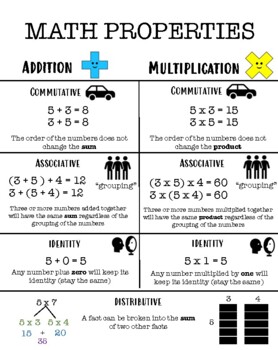Math Properties Poster/ Reference Sheet
Kristi Rhodes
4 Followers
Grade Levels
2nd - 12th
Subjects
Resource Type
Standards
CCSS3.OA.B.5
CCSS3.OA.C.7
CCSS3.OA.D.8
CCSS3.OA.D.9
Formats Included
- PDF
Kristi Rhodes
4 Followers
What educators are saying
This was a great resource for the front of my students binders as well as a large poster in my classroom.
Description
I created a math properties poster/ cheat sheet. It includes all of the properties for addition and multiplication.
-Commutative
-Associative
-Identity
-Distributive
You can print one out to laminate and hang on your math board, or give one to each student as a reference sheet. You can even bring a copy to your local printer store and they can copy it in a larger size to make a large poster. I hope you enjoy!
Total Pages
Answer Key
N/A
Teaching Duration
N/A
Report this resource to TPT
Reported resources will be reviewed by our team. Report this resource to let us know if this resource violates TPT’s content guidelines.
Standards
to see state-specific standards (only available in the US).
CCSS3.OA.B.5
Apply properties of operations as strategies to multiply and divide. Examples: If 6 × 4 = 24 is known, then 4 × 6 = 24 is also known. (Commutative property of multiplication.) 3 × 5 × 2 can be found by 3 × 5 = 15, then 15 × 2 = 30, or by 5 × 2 = 10, then 3 × 10 = 30. (Associative property of multiplication.) Knowing that 8 × 5 = 40 and 8 × 2 = 16, one can find 8 × 7 as 8 × (5 + 2) = (8 × 5) + (8 × 2) = 40 + 16 = 56. (Distributive property.)
CCSS3.OA.C.7
Fluently multiply and divide within 100, using strategies such as the relationship between multiplication and division (e.g., knowing that 8 × 5 = 40, one knows 40 ÷ 5 = 8) or properties of operations. By the end of Grade 3, know from memory all products of two one-digit numbers.
CCSS3.OA.D.8
Solve two-step word problems using the four operations. Represent these problems using equations with a letter standing for the unknown quantity. Assess the reasonableness of answers using mental computation and estimation strategies including rounding.
CCSS3.OA.D.9
Identify arithmetic patterns (including patterns in the addition table or multiplication table), and explain them using properties of operations. For example, observe that 4 times a number is always even, and explain why 4 times a number can be decomposed into two equal addends.


